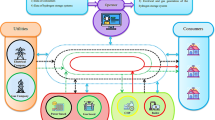Abstract
In Germany, the huge integration of small photovoltaic (PV) systems into the distribution grid during the past years leads to power quality issues due to the intermittent generation and reverse power flow in periods of low demand. To decrease this impact, different solutions are being investigated. The scope of this paper is to compare different strategies to control the charge power for residential PV storage systems for different load curves and to decide which might be the economically most profitable strategy. For this purpose, three different PV storage system control strategies were analyzed using MATLAB®to perform 1-year simulations on a minute step base. Measured input data from a PV system in the south of Germany were combined with four measured (extreme) load profiles and a standard load profile to conduct a sensitivity analysis. Performance indicators, such as self-consumption ratio (SCR), self-supply ratio (SSR), and share of losses ratio (SLR), were used to compare the different control strategies. Furthermore, an economic analysis of these results was performed to obtain the profitability of every control strategy and to determine the most profitable strategy, considering the household owner’s benefits.










Similar content being viewed by others
References
BDEW Bundesverband der Energie und Wasserwirtschaft. ,,Erneuerbare Energien und das EEG: Zahlen, Fakten, Grafiken (2016), Anlagen, installierte Leistung, Stromerzeugung, EEG - Auszahlungen, Marktintegration der Erneuerbaren Energien und regionale Verteilung der EEG— Anlagen“, Berlin, 18 Feb 2016
Wirth H (2015) Aktuelle Fakten zur Photovoltaik in Deutschland (Date 7.1.2015), Fraunhofer ISE
Gesetz für den Ausbau erneuerbarer Energien (Erneuerbare-Energien-Gesetz—EEG 2014)
Kairies K-P, Magnor D, Sauer DU (2015) Scientific measuring and evaluation program for photovoltaic battery systems (WMEP PV-Speicher). Energy Proc 73:200–207
Resch M, Ramadhani B, Bühler J, Sumper A (2015) Comparison of control strategies for residential PV storage systems. In: 9th International renewable energy storage conference and exhibition (IRES 2015), Messe Düsseldorf, 9–11 March 2015
Weniger J, Bergner J, Quaschning V (2014) Integration of PV power and load forecasts into the operation of residential PV battery systems. In: 4th Solar Integration Workshop, pp. 383–390
Weniger J, Tjaden T, Quaschning V (2013) Sizing and grid integration of residential PV battery systems. In: 8th International renewable energy storage conference and exhibition (IRES)
Tjaden T, Bergner J, Weniger J, Quaschning V (2015) Repräsentative elektrische Lastprofile für Wohngebäude in Deutschland auf 1-sekünde Datenbasis. Forschungsgruppe Solarspeichersysteme, HTW Berlin—University of Applied Sciences, Berlin
Weniger J, Bergner J, Tjaden T, Quaschning V (2015) Dezentrale Solarstromspeicher für die Energiewende. HTW Berlin—University of Applied Sciences, Berlin
Williams C, Binder J, Danzer M, Sehnke F, Felder M (2013) Battery charge control schemes for increased grid compatibility of decentralized PV systems. In: 28th Eur. Photovolt. Sol. Energy Conf. Exhib
Bergner J, Weniger J, Tjaden T, Quaschning V (2014) Feed-in power limitation of grid-connected PV battery systems with autonomous forecast-based operation strategies. In: 29th European photovoltaic solar energy conference and exhibition, Amsterdam
BDEW Bundesverband der Energie- und Wasserwirtschaft e.V. (2015) Erneuerbare Energien und das EEG: Zahlen, Fakten, Grafiken (2015), Berlin, 11. Mai 2015
Bundesnetzagentur (2015) Bestimmung der Förderssätze für Fotovoltaikanlagen §31 EEG 2014 für die Kalendermonate Oktober 2015, November 2015 und Dezember 2015
Acknowledgments
This work was supported by the German Federal Ministry of Economics and Technology (BMWi) and the Projektträger Jülich GmbH (PTJ) within the framework of the project “SmartPowerFlow” (FKZ0325523A). We thank also the joint research partners from the SMA AG, the Lechwerke Verteilnetze GmbH (LVN) as well as the Younicos AG for their great support. The authors gratefully acknowledge the contributions of the research group Solar Storage Systems of the HTW Berlin.
Author information
Authors and Affiliations
Corresponding author
Rights and permissions
About this article
Cite this article
Rascon, O.C., Resch, M., Bühler, J. et al. Techno-economic comparison of a schedule-based and a forecast-based control strategy for residential photovoltaic storage systems in Germany. Electr Eng 98, 375–383 (2016). https://doi.org/10.1007/s00202-016-0429-7
Received:
Accepted:
Published:
Issue Date:
DOI: https://doi.org/10.1007/s00202-016-0429-7




